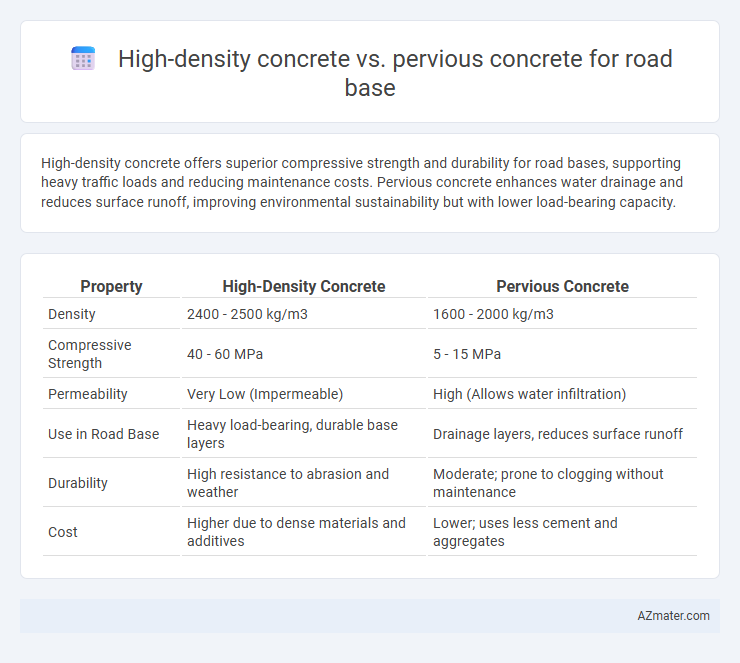High-density concrete offers superior compressive strength and durability for road bases, supporting heavy traffic loads and reducing maintenance costs. Pervious concrete enhances water drainage and reduces surface runoff, improving environmental sustainability but with lower load-bearing capacity.
Table of Comparison
| Property | High-Density Concrete | Pervious Concrete |
|---|---|---|
| Density | 2400 - 2500 kg/m3 | 1600 - 2000 kg/m3 |
| Compressive Strength | 40 - 60 MPa | 5 - 15 MPa |
| Permeability | Very Low (Impermeable) | High (Allows water infiltration) |
| Use in Road Base | Heavy load-bearing, durable base layers | Drainage layers, reduces surface runoff |
| Durability | High resistance to abrasion and weather | Moderate; prone to clogging without maintenance |
| Cost | Higher due to dense materials and additives | Lower; uses less cement and aggregates |
Introduction to High-Density and Pervious Concrete
High-density concrete incorporates aggregates with high specific gravity such as barite or magnetite, enhancing compressive strength and radiation shielding, making it suitable for heavy load-bearing road bases. Pervious concrete features interconnected pores that allow water to permeate through the material, reducing surface runoff and improving drainage for sustainable road base applications. Both types serve specialized functions: high-density concrete prioritizes strength and durability, while pervious concrete emphasizes environmental benefits and stormwater management.
Definition and Composition of High-Density Concrete
High-density concrete is a specialized concrete mixture characterized by heavyweight aggregates such as magnetite, barite, or hematite, resulting in a density typically above 3000 kg/m3, compared to conventional concrete's 2400 kg/m3. Its composition includes a high proportion of heavy aggregates combined with cement, water, and admixtures designed to enhance strength and durability. In contrast to pervious concrete, which incorporates a high volume of coarse aggregates and little to no fine aggregates to allow water permeability, high-density concrete provides enhanced load-bearing capacity and radiation shielding, making it suitable for road bases requiring superior strength and durability.
Definition and Composition of Pervious Concrete
Pervious concrete is a highly porous material designed to allow water to pass through, composed primarily of cement, coarse aggregates, water, and minimal fine aggregates to create void spaces for permeability. Unlike high-density concrete, which has a dense matrix with fine aggregates and lower porosity for maximum strength and durability, pervious concrete emphasizes drainage and is used to reduce runoff and improve stormwater management in road base applications. The unique composition of pervious concrete supports environmental sustainability while providing sufficient structural support for road bases in low-traffic areas.
Structural Strength and Load-Bearing Capacity
High-density concrete exhibits superior structural strength and load-bearing capacity due to its dense aggregate composition and low porosity, making it ideal for heavy traffic road bases. Pervious concrete, with its high porosity and permeability, offers reduced structural strength, limiting its use to lighter load applications or areas requiring enhanced drainage. Engineers prioritize high-density concrete for road bases subjected to heavy vehicular loads to ensure long-term durability and stability.
Drainage and Permeability Comparison
High-density concrete exhibits low permeability, making it suitable for road bases requiring strong load-bearing capacity but poor drainage. Pervious concrete, characterized by its high porosity, enables rapid water infiltration, significantly reducing surface runoff and enhancing drainage. The permeability rate of pervious concrete can exceed 1,000 inches per hour, vastly outperforming high-density concrete which typically has permeability near zero.
Durability and Maintenance Requirements
High-density concrete offers superior durability for road bases due to its low permeability and high compressive strength, reducing the risk of cracking and water damage over time. Pervious concrete, while providing excellent drainage properties, typically requires more frequent maintenance to prevent clogging and preserve its permeability, especially in heavy traffic areas. Choosing high-density concrete minimizes long-term repairs and enhances structural integrity, whereas pervious concrete benefits stormwater management but demands regular upkeep.
Environmental Impact and Sustainability
High-density concrete offers superior compressive strength and durability for road bases but has a higher carbon footprint due to increased cement content and energy-intensive production processes. Pervious concrete enhances environmental sustainability by allowing stormwater infiltration, reducing runoff, and replenishing groundwater, which mitigates urban flooding and supports ecosystem health. Selecting pervious concrete for road bases aligns with sustainable infrastructure goals by lowering environmental impact and promoting resource-efficient water management.
Applications in Road Base Construction
High-density concrete offers superior load-bearing capacity and durability, making it ideal for heavy-traffic road base applications requiring long-term stability. Pervious concrete facilitates efficient stormwater drainage, reducing surface runoff and promoting groundwater recharge in road base layers located in environmentally sensitive or urban areas. Selecting between the two depends on project priorities such as structural strength or environmental sustainability in road base construction.
Cost Analysis and Economic Considerations
High-density concrete typically incurs higher initial material and installation costs due to its dense aggregates and cement content, but offers superior load-bearing capacity and durability, potentially reducing long-term maintenance expenses in road base applications. Pervious concrete, while generally more cost-effective upfront, involves additional costs related to specialized construction techniques and frequent maintenance to prevent clogging and preserve permeability, impacting its economic viability. Evaluating lifecycle costs and site-specific performance requirements informs optimal material selection between these concrete types for road base projects.
Conclusion: Selecting the Optimal Concrete for Road Bases
High-density concrete offers superior compressive strength and durability, making it ideal for heavy traffic loads and long-term road base stability. Pervious concrete enhances water drainage and reduces surface runoff, promoting sustainable urban drainage systems but generally has lower load-bearing capacity. Selecting the optimal concrete depends on project requirements: high-density concrete suits highways and heavily trafficked roads, while pervious concrete is preferable for areas prioritizing stormwater management and environmental benefits.

Infographic: High-density concrete vs Pervious concrete for Road base
 azmater.com
azmater.com